Cataloguing efforts uncover a royal gift to the University of St Andrews from the King of Siam in 1896
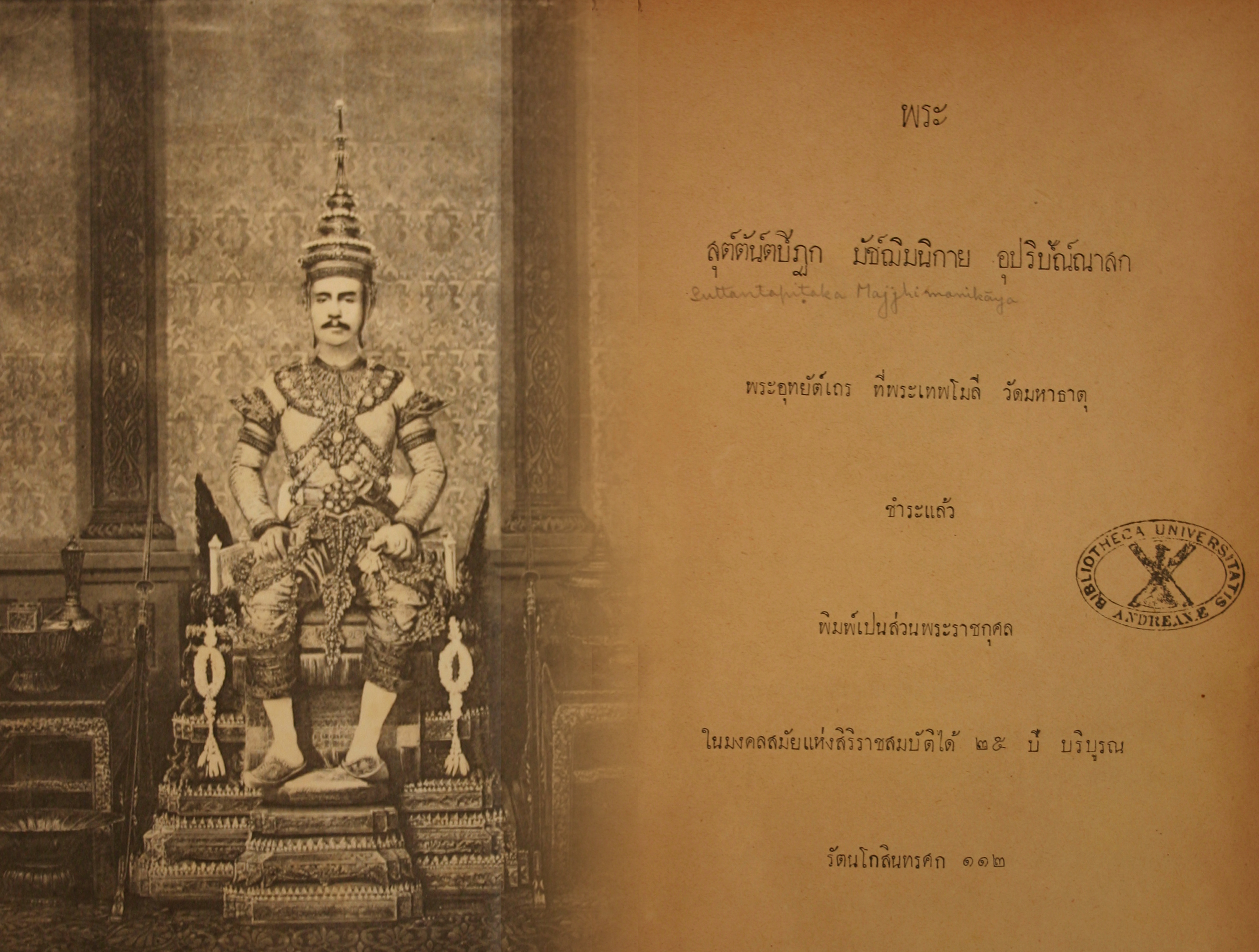
In 1893, King Chulalongkorn ordered the first printing ever of the Tipitaka (or, “the three baskets,” the Pali canon which forms the doctrinal foundation of Theravada Buddhism) which had previously only existed in manuscript form written on palm leaves. This canon was first composed in North India and was preserved and passed orally until it was first committed to writing around 29 BCE. It is traditionally believed by Theravadins that most of the Pali Canon originated from the Buddha and his immediate disciples. Because of the fragility of these palm-leaf manuscripts and the climate of Theravadin countries, most surviving manuscripts are only fragmentary and date from the 15th century or later. Chulalongkorn’s reign as King of Siam was marked by great steps forward in the modernization of his country, by progressive social reform and by the protection of his kingdom from Western colonialism. To mark the 25th anniversary of his coronation and fulfilling his royal role as protector of the Buddhist faith, Chulalongkorn had this set of the sacred Pali texts, totalling 39 volumes, printed in modern-typeface of the Siam script. These books were printed and bound in Bangkok, and then sent as royal gifts to 260 institutes across five continents in 1896.
This video, below, assembled by the World Tipitaka Project, is in Thai with some English subtitles. It provides some insights into the historical context of this edition, and the final graphic at around the 4:00 mark shows the distribution of the Chulalongkorn Tipitaka very nicely.
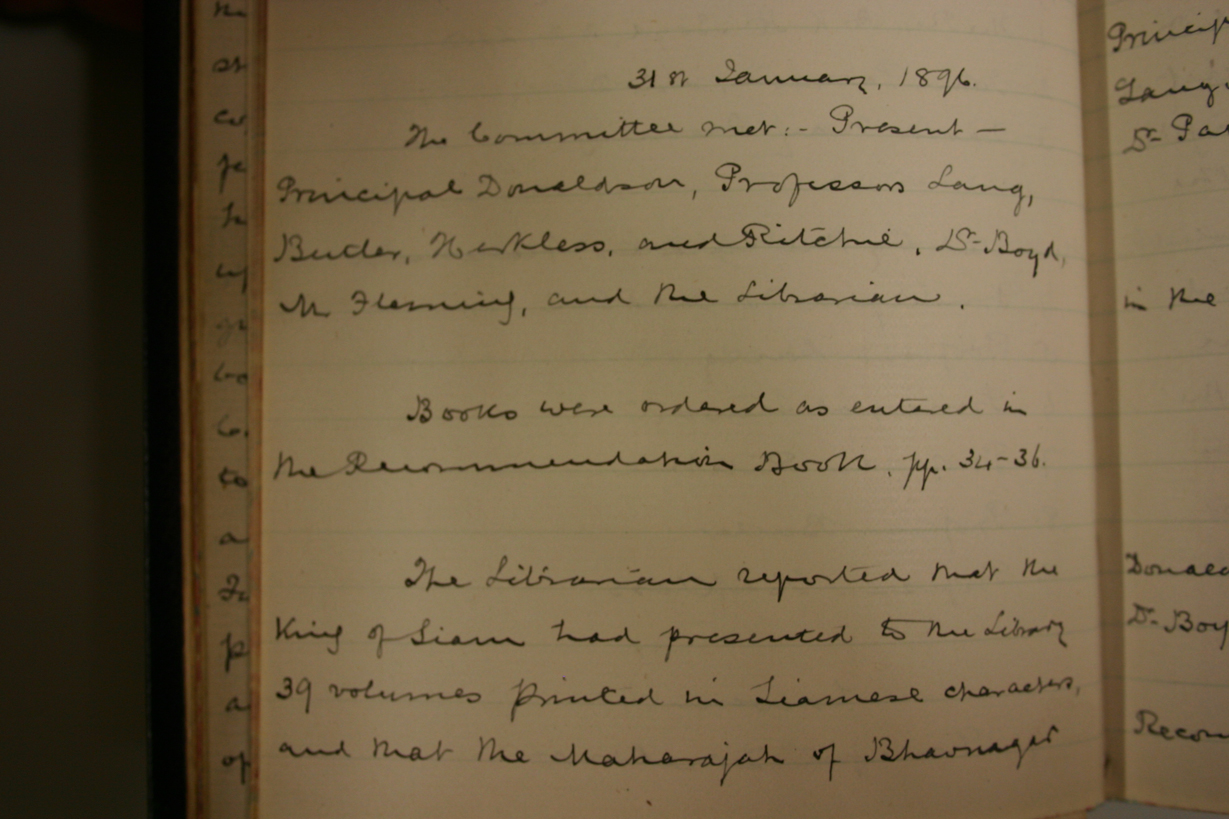
In 1896, the University of St Andrews Library minutes record a donation of 39 volumes from Chulalongkorn and acknowledged that a letter of thanks should be sent. These volumes, because of their language, their script, or perhaps their nature, were left uncatalogued and unrecorded for over a hundred years, their significance was lost and their meaning forgotten. At some point this collection came under the care of the Department of Special Collections, and was labelled the “Thailand Collection” and there it has remained, untouched, until this summer. It was decided, then, that we should truly figure out what this mysterous set of books was, and so we posted a call for help in order to decipher the script and their nature, and to catalogue them properly. We advertised internally to any Thai-language student for a short, 20 hour project to help us with this task. Waranunt Pongpairoj was the first to reply to this ad, “I was pleasantly surprised that there were some Thai books in the university’s library because there are so few connections between Scotland and Thailand that I know of. What surprised me even more when I read through the email is the fact that the collection was a century-old royal gift from HRH King Rama V, the founder of my previous university [Chulalongkorn University].”
“…the fact that it was a royal gift for the university still dangled in my mind. Call me nosy, but I wanted to know the whole story.”
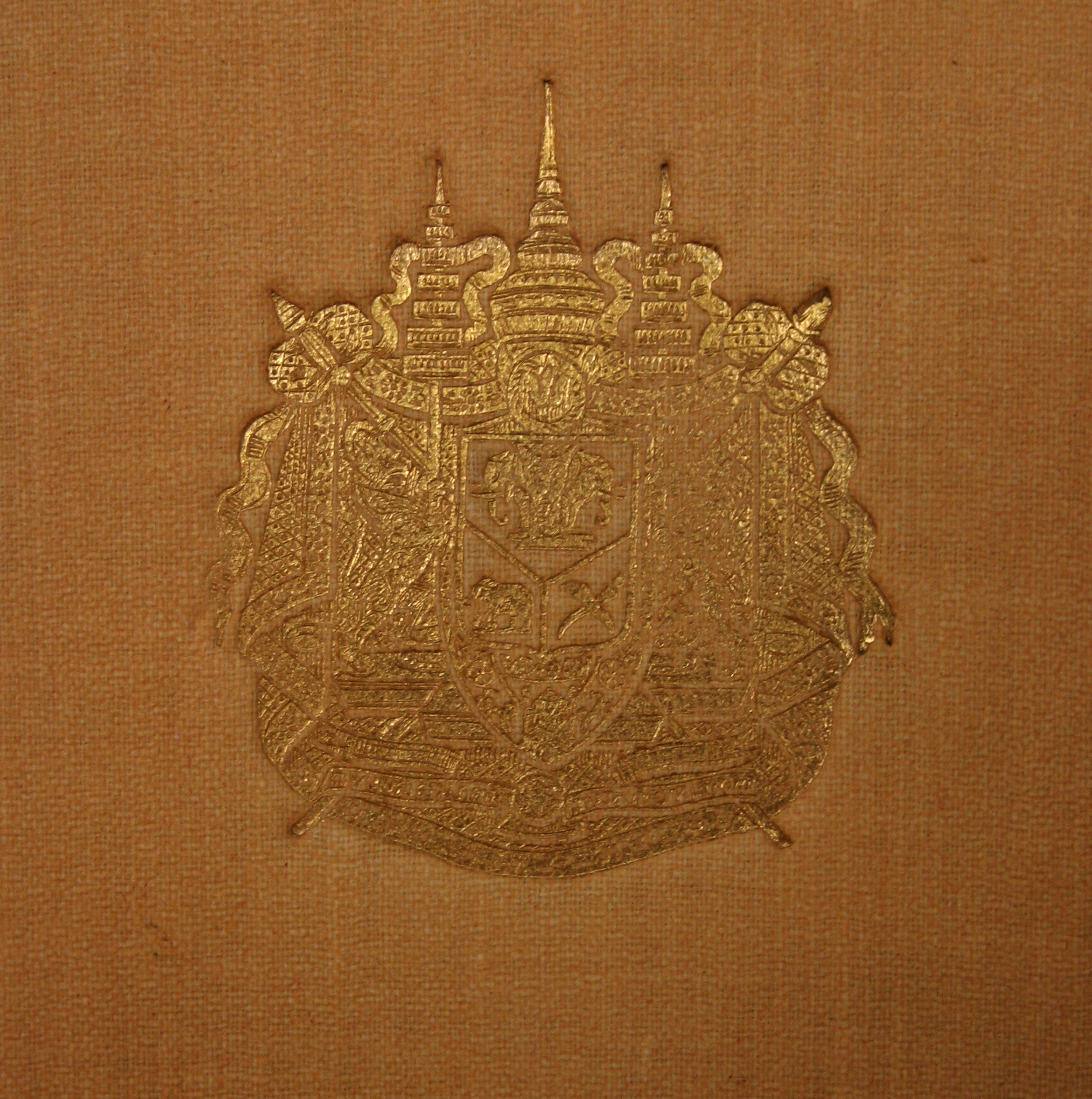
Work began in early June 2012 to identify these books, as Wara recounts her first day: “It was in the humidity-controlled room that I first met the collection of 39 books. After a quick examination, I knew that they are the Theravada Tripitaka and that intimidated me. Indeed, I have never in my life dealt with this kind of sacred texts … nevertheless, the opportunity was too good to let go. In fact, it is not often that you are a Thai student in a Scottish university in want of help for cataloguing some Thai books. Also, the fact that it was a royal gift for the university still dangled in my mind. Call me nosy, but I wanted to know the whole story. That being so, I gave in to my curiosity and signed the work contract, and I never regretted doing so.”
Wara quickly identified this set as the “Chulalongkorn Tipitaka”, and instantly the story became more interesting and, indeed, more serious. While Wara worked away at transcribing, transliterating and translating each title page, I began researching the history of this edition of the Tipitaka. I quickly found out that the Dhamma Society was set up in the mid-1990s to produce a Latin script Tipitaka and to fund and promote research of the Pali Tipitaka. This society has funded the research necessary in producing this new edition, but also has set up the International Tipitaka Hall at Chulalongkorn University, provided a digital facsimile of the 1893 edition and has funded bibliographic research in this area. In 2009, a project that tracked which countries recieved the 1893 Chulalongkorn Tipitaka was completed which resulted in a repository being set up for institutions to report their holdings, which we now have done. It was through this research that I found out that we are the first British institution to report our holdings to the World Tipitaka Repository, and the first to catalogue a full, extant set. There are portions of these sets recorded at the British Library, Oxford and Cambridge, but none are complete records, and, indeed, some of the institutions record only a brief holdings statement.
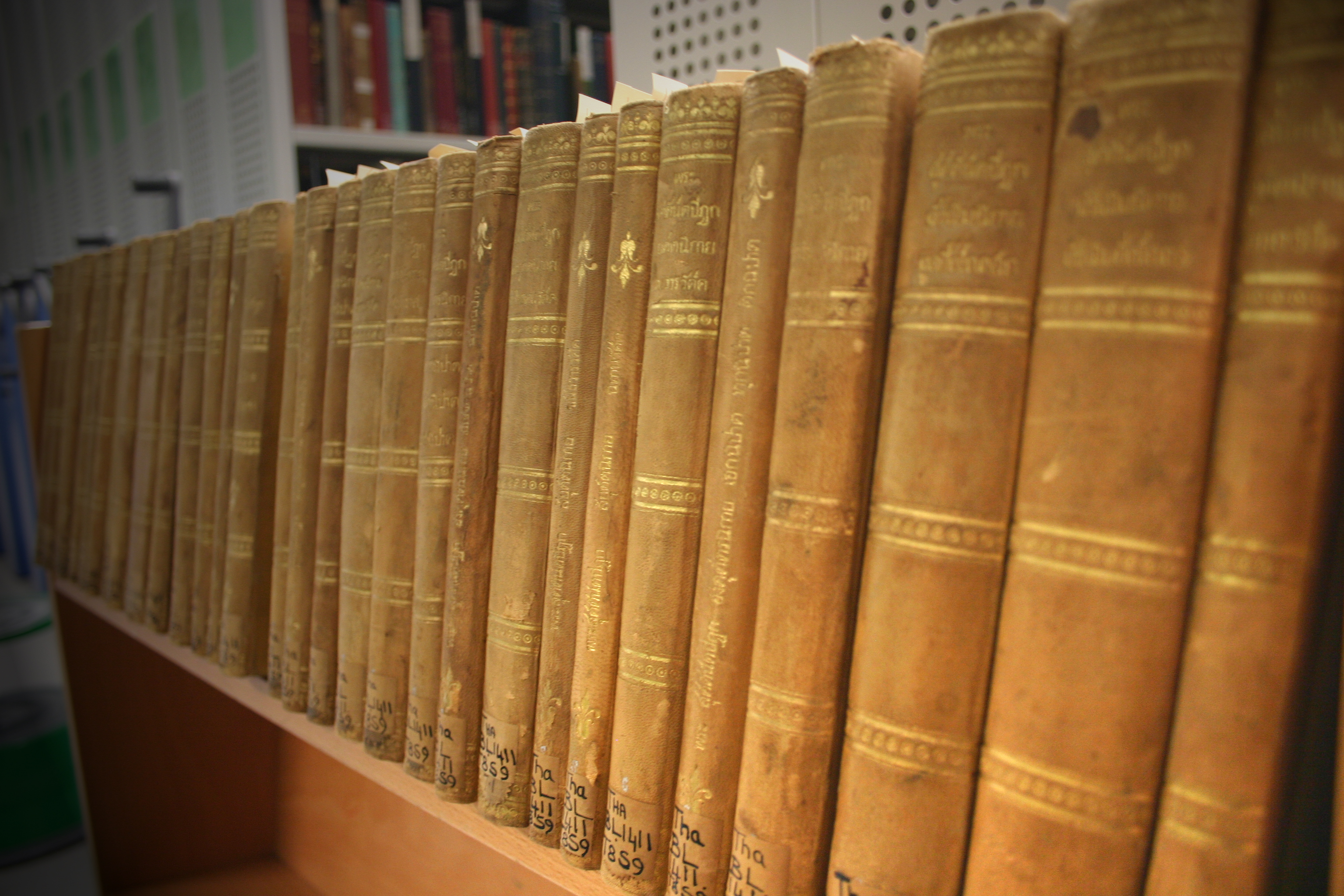
“The most fascinating part of this project has to be the fact that this set of books is part of the World’s first printed Tipitaka,” says Wara, “It was, indeed, the vision of the King that had made this happen. In my opinion, this action not only illustrates the revolution of the Siamese-Buddhist printing technology, but it also had strong political implications for my country. On the same year that this Tipitaka was printed, Thailand, then called the Kingdom of Siam, suffered from the inequitable treaty with France, resulting in Siam having to surrender the land on the upper left side of Mekhong river to the French government. It was during this period of land-war that Siam lost considerable amount of land possessions in order to secure its sovereignty, weakening the power of the kingdom. However, I believe that the fact that this Tipitaka had been printed signifies the exercise of power, not military but of education and technology, for the collection had been distributed to educational institutions, and not governments, all over the world. It is thus a privilege for me to be a part of the cataloguing of this collection. Despite the honour, I feel that my ignorance about my country and its history has made me unworthy of this task. Nevertheless, I resolved that it was never to late to do the research, so I did and I have now learnt a lot more about this version of the Tipitaka.”
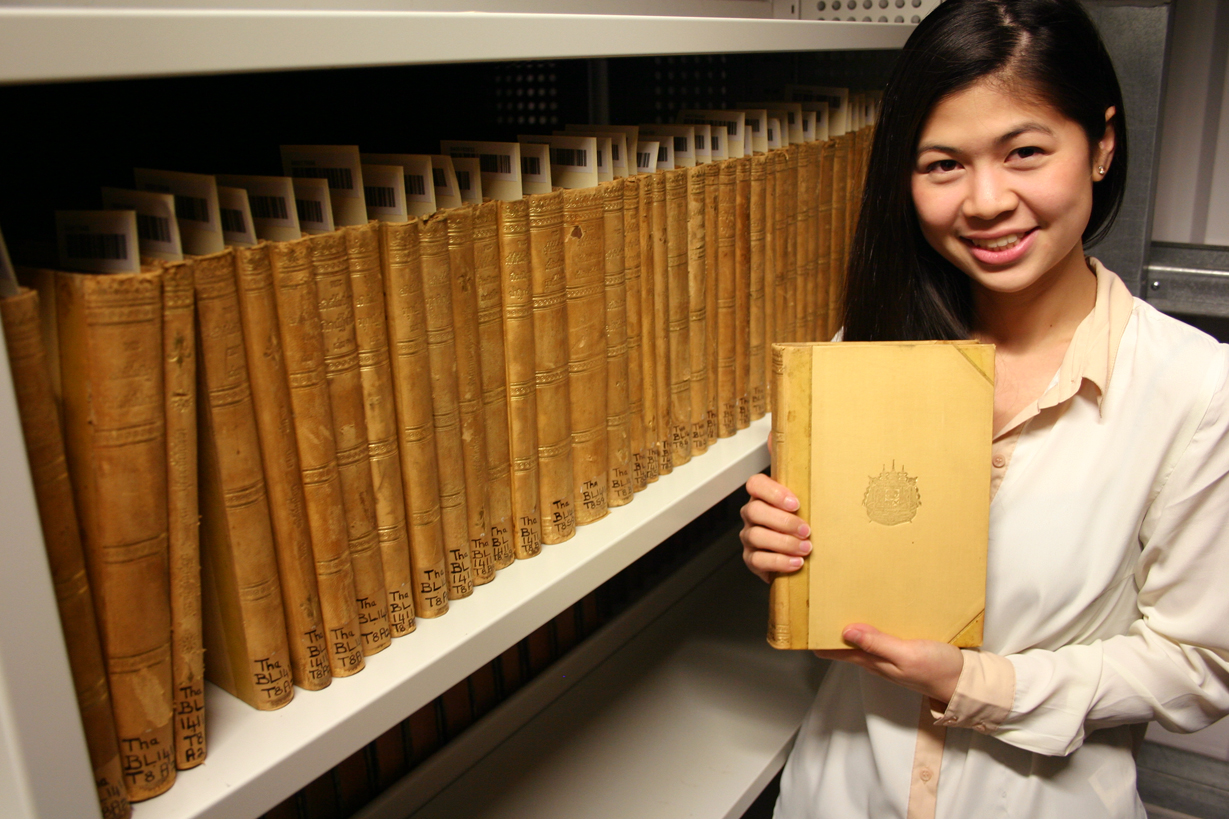
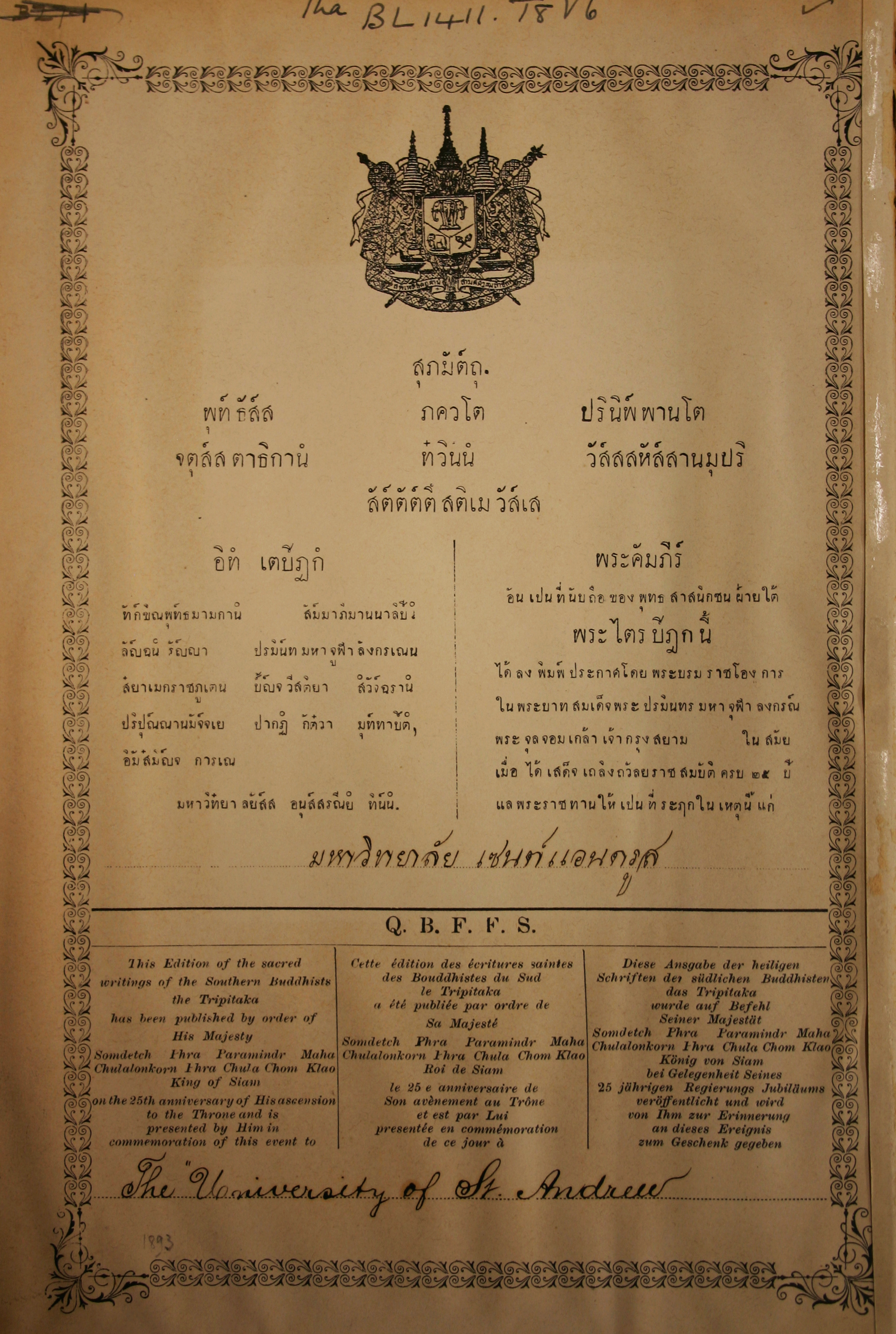
Cataloguing of the Chulalongkorn Tipitaka has now been completed, and all of the records have been made available on the University of St Andrews online catalogue, SAULCAT. These records include a uniform title heading for each book of the Tipitaka, a Thai character transcription of the title page, a transliteration of the title page and an English translation of each book of the Tipitaka. They also include indexed headings for the editors and temples they were associated with, as well as full pagination descriptions and subject headings. These catalogue records will be uploaded to COPAC and WorldCAT and it is our hope that institutions which hold a set of these works can download these records and use them to provide access to this wonderful resource.
This has, indeed, been a fascinating project which began solely as a cataloguing exercise. When I first came across these volumes I was unsure of their content or the story that they could tell, the only hint was found in a presentation bookplate found in the first volume. I am glad that we have finally found out what these books are, how important they are and the history that surrounds them, and it is my hope that now they can be used by students and researchers alike. I also hope that this bit of publicity will alert institutions which hold sets of this Tipitaka to their importance and to the fact that the catalogue records for these books are freely available to download into their library systems, and that a more full picture of the international holdings of the Chulalongkorn donation will emerge.
–DG & Waranunt Pongpairoj
Wara is currently working on her Management Master’s degree in the School of Management at the University of St Andrews. She previously studied English and French at the Faculty of Arts, Chulalongkorn University.
—
จากรายการหนังสือหายากในห้องสมุดมหาวิทยาลัยเซนต์แอนดรูวส์สู่การค้นพบชุดของขวัญพระราชทานในพระมหากษัตริย์จากสยามประเทศ ปี พ.ศ. ๒๔๓๙

ในปี ร.ศ.๑๑๒ (พ.ศ. ๒๔๓๖) พระบาทสมเด็จพระจุลจอมเกล้าเจ้าอยู่หัวมีพระราชดำริให้จัดพิมพ์พระไตรปิฎกฉบับเถรวาทเป็นรูปเล่มหนังสือขึ้นเป็นครั้งแรก จากที่เคยเป็นเพียงอักษรจารบนสมุดไทย พระไตรปิฎกนั้นเกิดขึ้นในประเทศอินเดียตอนเหนือและได้มีการเผยแพร่ในรูปแบบวรรณกรรมมุขปาฐะ จนกระทั่งได้มีการจารบนสมุดไทยเพื่ออนุรักษ์ไว้ในพุทธศักราช ๒๙ ชาวพุทธนิกายเถรวาทนั้นเชื่อว่า
พระคัมภีร์ต่างๆในพระไตรปิฎกเกิดจากการรวบรวมคำสอนและเรื่องราวขององค์สมเด็จพระสัมมาสัมพุทธเจ้าและอนุศิษย์สงฆ์ แต่เนื่องจากภูมิอากาศร้อนชื้นในแถบประเทศที่นับถือศาสนาพุทธนิกายเถรวาทประกอบกับความเปราะของใบลาน ทำให้พระไตรปิฎกใบลานที่พบในปัจจุบันไม่ครบถ้วน ส่วนที่พบนั้นมักเป็นพระไตรปิฎกที่จารในคริสตศตวรรษที่ ๑๕ หรือใหม่กว่านั้น
รัชสมัยของพระบาทสมเด็จพระจุลจอมเกล้าเจ้าอยู่หัวนั้นได้ชื่อว่าเป็นรัชสมัยแห่งการพัฒนาประเทศเพื่อให้ทัดเทียมชาติตะวันตก ทั้งในการปฏิรูปสังคมแบบก้าวหน้าและการรักษาเอกราชจากการตกเป็นเมืองขึ้นของประเทศตะวันตก ในรัชสมัยแห่งความรุ่งเรืองนี้เอง พระบาทสมเด็จพระจุลจอมเกล้าเจ้าอยู่หัวได้มีพระราชดำริให้จัดพิมพ์พระไตรปิฎกฉบับ ๓๙ เล่ม ขึ้นเป็นตัวอักษรสยามแบบทันสมัยเพื่อเฉลิมฉลองในมงคลสมัยแห่งสิริราชสมบัติ ๒๕ ปีและเพื่อปฏิบัติหน้าที่ของพระมหากษัตริย์โดยสมบูรณ์ในฐานะที่ทรงเป็นองค์อัครศานูปถัมภก จึงได้มีการจัดพิมพ์และเย็บเล่มพระไตรปิฎกในกรุงเทพมหานครและจัดส่งไปตามสถาบันการศึกษา ๒๖๐ แห่งใน ๕ ทวีปในปีพ.ศ. ๒๔๓๖
วีดิทัศน์ด้านล่างจัดทำโดยโครงการพระไตรปิฎกโลกเป็นภาษาไทยพร้อมคำบรรยายใต้ภาพภาษาอังกฤษ เนื้อหาในวีดิทัศน์กล่าวถึงบริบททางประวัติศาสตร์ของการจัดพิมพ์พระไตรปิฎกฉบับดังกล่าวได้เป็นอย่างดี ภาพกราฟฟิกในนาทีที่๔.๐๐ แสดงการเผยแพร่พระไตรปิฎกฉบับพระบาทสมเด็จพระจุลจอมเกล้าเจ้าอยู่หัว

ในปีพ.ศ. ๒๔๓๙ มีบันทึกการรับมอบพระไตรปิฎกฉบับ ๓๙ เล่ม จากพระบาทสมเด็จพระจุลจอมเกล้าเจ้าอยู่หัว และยังมีบันทึกข้อความการส่งจดหมายขอบคุณอีกด้วย อย่างไรก็ตาม เนื่องจากภาษาและลักษณะตัวอักษรที่แปลกตาทำให้พระไตรปิฎกทั้ง ๓๙ เล่มถูกปล่อยทิ้งไว้โดยไม่ได้รับการจัดรายการหรือบันทึกเข้าในบัญชีรายการหนังสือเป็นเวลากว่าหนึ่งร้อยปี ความหมายและความสำคัญของหนังสือดังกล่าวก็ได้สูญหายไปตามกาลเวลา ต่อมาได้มีการส่งพระไตรปิฎกชุดนี้มาในความรับผิดชอบของแผนกหนังสือพิเศษ (Special Collection Department) และหลังจากได้มีการนิยามหนังสือชุดนี้ว่า “Thailand Collection” ก็ไม่มีผู้ใดมาสานต่อโครงการอีกจนกระทั่งฤดูร้อนนี้ ทางแผนกฯได้ตัดสินใจทำการค้นคว้าเกี่ยวกับหนังสือชุดนี้และได้ประกาศหาบุคลากรเพื่อมาช่วยแกะความหมายของตัวอักษรและภาษาดังกล่าว เพื่อทำการจัดจำแนกหนังสือลงบัญชีรายการห้องสมุดอย่างถูกต้อง เราได้ประกาศหนังสือเวียนภายในเพื่อหานักเรียนไทยมาร่วมทำโครงการดังกล่าว โดยกำหนดเป็นระยะเวลา ๒๐ ชั่วโมง วรนันทน์ พงศ์ไพโรจน์เป็นนักเรียนคนแรกที่ตอบประกาศมา “ตอนแรกประหลาดใจมากค่ะที่รู้ว่ามีหนังสือไทยอยู่ในห้องสมุดเพราะคิดว่าประเทศไทยกับสก็อตแลนด์มีความเกี่ยวโยงกันน้อยมาก ที่แปลกใจยิ่งไปกว่านั้นคือตอนที่อ่านอีเมล์แล้วทราบว่าหนังสือชุดนี้เป็นของขวัญพระราชทานจากล้นเกล้ารัชกาลที่ ๕ พระผู้สร้างและมีพระมหากรุณาธิคุณต่อจุฬาลงกรณ์มหาวิทยาลัยที่เคยศึกษาในระดับปริญญาตรี”
“ความที่หนังสือชุดดังกล่าวเป็นของพระราชทานทำให้ติดใจสงสัยค่ะ จะว่ายุ่งก็ได้แต่ก็อยากรู้เรื่องราวทั้งหมดว่าเป็นอย่างไรกันแน่”

งานหนังสือได้เริ่มขึ้นในเดือนมิถุนายน พ.ศ. ๒๕๕๕ วรนันทน์เล่าถึงวันแรกในการทำงาน “ครั้งแรกที่เห็นหนังสือเซ็ต ๓๙ เล่มนี้คือในห้องควบคุมความชื้นของมหาวิทยาลัยค่ะพอเปิดดูแล้วก็พอจะบอกได้ว่าเป็นพระไตรปิฎกภาษาบาลี พอรู้อย่างนั้นก็กลัวมากเพราะชีวิตนี้ไม่เคยต้องทำงานเกี่ยวข้องกับหนังสือประเภทนี้มาก่อน…แต่ว่าคิดว่าโอกาสดีขนาดนี้ก็ไม่ควรจะปล่อยให้หลุดลอยไป จริงๆแล้วก็ไม่บ่อยที่เราจะเป็นนักเรียนไทยในมหาวิทยาลัยสก็อตแลนด์แล้วมีประกาศหาคนช่วยจัดรายการหนังสือไทยนอกจากนี้ก็คือ ความที่หนังสือชุดดังกล่าวเป็นของพระราชทานทำให้สนใจค่ะ จะว่ายุ่งก็ได้แต่ก็อยากรู้เรื่องราวทั้งหมดว่าเป็นอย่างไรกันแน่ ในที่สุดก็เลยยอมแพ้ต่อความสงสัยของตัวเองแล้วก็เซ็นสัญญาทำงาน หลังจากนั้นก็ไม่เคยเสียใจกับการตัดสินใจของตัวเองอีกเลย”
วรนันทน์ใช้เวลาไม่นานก็สามารถระบุได้ว่าหนังสือดังกล่าวเป็นพระไตรปิฎกฉบับจุลจอมเกล้าเจ้าอยู่หัว เมื่อรู้ดังนั้น เรื่องทั้งหมดก็น่าสนใจมากขึ้น และแน่นอนว่ากลายเป็นเรื่องที่จริงจังมากขึ้น ในขณะที่วรนันทน์จัดการถ่ายเสียงและแปลหน้าแรกของคัมภีร์แต่ละเล่ม ผมก็เริ่มค้นคว้าเพิ่มเติมเกี่ยวกับพระไตรปิฎกชุดนี้ และค้นพบอย่างรวดเร็วว่า ได้มีการก่อตั้งสมาคมธรรมะ (Dhamma Society) ขึ้นในช่วงกลางทศวรรษ ๑๙๙๐ เพื่อจัดทำพระไตรปิฎกฉบับตัวอักษรละตินและเพื่อสนับสนุนและสมทบทุนการวิจัยพระไตรปิฎกบาลี สมาคมดังกล่าวได้ทำการสมทบทุนงานวิจัยต่างๆเพื่อการผลิตพระไตรปิฎกฉบับใหม่นี้ และยังได้ก่อตั้ง หอสมุดไตรปิฎกนานาชาติ (International Tipitaka Hall) ขึ้นที่จุฬาลงกรณ์มหาวิทยาลัย ซึ่งจัดเก็บสำเนาดิจิตอลของพระไตรปิฎกฉบับจุลจอมเกล้าเจ้าอยู่หัว และสมทบทุนงานวิจัยสารนิเทศในเรื่องดังกล่าว ในปีพ.ศ. ๒๕๕๒ โครงการระบุประเทศที่ได้รับพระราชทานพระไตรปิฎกฉบับจุลจอมเกล้าเจ้าอยู่หัวก็เสร็จสิ้น มีการระบุให้สถาบันที่มีพระไตรปิฎกฉบับจุลจอมเกล้าเจ้าอยู่หัวอยู่ในครอบครองแจ้งรายการดังกล่าว ซึ่งทางเราก็ได้ทำเรียบร้อยแล้ว จากการค้นคว้านี้เองที่ทำให้ผมทราบว่าเราเป็นสถาบันแรกในสหราชอาณาจักรที่รายงานต่อคลังพระไตรปิฎกโลก (World Tipitaka Repository) ว่ามีพระไตรปิฎกฉบับดังกล่าวครบทั้ง ๓๙เล่ม มีพระไตรปิฎกชุดนี้บางส่วนได้รับการบันทึกอยู่ที่หอสมุดสหราชอาณาจักร (The British Library) ที่มหาวิทยาลัยอ็อกซฟอร์ด และ เคมบริจด์ แต่ไม่มีที่ไหนเลยที่มีรายการบันทึกอย่างครบถ้วน และรายการบันทึกของบางสถาบันก็เป็นเพียงการครอบครองชั่วคราว

“สิ่งที่น่าตื่นเต้นที่สุดในโครงการนี้ก็คือการที่พระไตรปิฎกฉบับจุลจอมเกล้าเจ้าอยู่หัวนี้เป็นฉบับแรกในโลกที่พิมพ์ด้วยเครื่องพิมพ์” วรนันทน์กล่าว “แน่นอนว่า เป็นวิสัยทัศน์อันก้าวไกลของรัชกาลที่ ๕ การมีพระราชดำริให้จัดพิมพ์ขึ้น ไม่เพียงแสดงให้เห็นถึงเทคโนโลยีการพิมพ์ในประเทศไทย แต่ยังมีนัยยะการเมืองเข้ามาเกี่ยวข้องอีกด้วย ปีที่จัดพิมพ์พระไตรปิฎกฉบับจุลจอมเกล้าเจ้าอยู่หัวนั้นเป็นปีเดียวกับที่ประเทศไทย (ซึ่งขณะนั้นคือสยามประเทศ) เกิดกรณีพิพาทกับประเทศฝรั่งเศสและต้องเซ็นสนธิสัญญา อันส่งผลให้สูญเสียอาณานิคมฝั่งซ้ายของแม่น้ำโขงแก่รัฐบาลฝรั่งเศส ในช่วงนี้นี่เองที่สยามได้สูญเสียดินแดนจำนวนมากเพื่อรักษาเอกราชของตนเอง ยังผลให้อำนาจของราชอาณาจักรอ่อนลงไปด้วย อย่างไรก็ดี เชื่อว่าการพิมพ์พระไตรปิฎกฉบับจุลจอมเกล้าเจ้าอยู่หัวนี้ เป็นการแสดงถึงอำนาจในอีกรูปแบบหนึ่ง อาจไม่ใช่อำนาจทางการทหาร แต่เป็นอำนาจทางการศึกษาและเทคโนโลยี โดยเฉพาะอย่างยิ่งเมื่อมีการส่งพระไตรปิฎกไปสถาบันการศึกษาต่างๆทั่วโลก รู้สึกเป็นเกียรติมากที่ได้มีโอกาสมีส่วนร่วมในการจัดรายการหนังสือนี้ ถึงจะเป็นเกียรติแต่ก็รู้สึกว่าความรู้เกี่ยวกับประวัติศาสตร์ประเทศของตัวเองมีน้อยมากจนทำให้คิดว่าไม่คู่ควรที่จะทำงานนี้ค่ะ แต่ก็คิดได้ว่าอย่างไรก็ไม่สายเกินไปที่จะค้นคว้า ก็เลยทำ ตอนนี้ก็เลยได้เรียนรู้เกี่ยวกับพระไตรปิฎกฉบับจุลจอมเกล้าเจ้าอยู่หัวนี้มากขึ้นมาก”


การจัดบันทึกรายการหนังสือของพระไตรปิฎกฉบับจุลจอมเกล้าเจ้าอยู่หัวได้เสร็จสิ้นลงแล้ว และ บันทึกรายการดังกล่าว อยู่บนรายการหนังสือออนไลน์ SAULCAT ของมหาวิทยาลัยเซนต์แอนดรูวส์ บันทึกรายการดังกล่าวประกอบไปด้วย ชื่อคัมภีร์และหนังสือแต่ละเล่ม ตัวอ่านถอดเสียงและตัวหนังสือไทยของหน้าแรกในแต่ละเล่ม นอกจากนี้ยังมีรายชื่อผู้ชำระและวัดต่างๆที่เกี่ยวข้อง รวมถึงรายละเอียดหน้าหนังสือและหัวข้อ จะมีการอัพโหลดรายการบันทึกดังกล่าวขึ้นสู่ COPAC และ WorldCATและเราหวังว่าสถาบันต่างๆที่มีพระไตรปิฎกฉบับจุลจอมเกล้าเจ้าอยู่หัวอยู่ในครอบครองจะสามารถดาวน์โหลดบันทึกรายการดังกล่าวเพื่อที่จะเข้าถึงทรัพยากรสุดพิเศษนี้ได้
โครงการนี้เริ่มขึ้นเป็นเพียงแค่การจัดบันทึกหนังสือแต่ได้กลายเป็นโครงการที่น่าสนใจมาก ครั้งแรกที่ผมเห็นหนังสือชุดนี้ ผมไม่แน่ใจเลยว่าเป็นหนังสือเกี่ยวกับอะไรหรือจะมีเรื่องราวอะไรที่น่าสนใจ คำใบ้เดียวที่ผมได้รับก็คือสิ่งที่เขียนอยู่ในหน้าส่งมอบหนังสือที่พบในคัมภีร์เล่มแรก ผมรู้สึกดีใจมากที่ในที่สุดเราก็รู้ว่าหนังสือพวกนี้คืออะไรสำคัญเพียงไหนและเรื่องราวประวัติศาสตร์ที่เกี่ยวข้องเป็นอย่างไร ผมก็หวังว่าหนังสือชุดนี้จะเป็นประโยชน์ทั้งกับนักเรียนและนักวิจัย และผมก็หวังว่าการประกาศครั้งนี้จะกระตุ้นให้สถาบันต่างๆที่มีพระไตรปิฎกฉบับนี้ไว้ในครอบครองตระหนักถึงความสำคัญของพระไตรปิฎกฉบับนี้ และบันทึกรายการของหนังสือชุดนี้สามารถดาวน์โหลดลงในระบบสารนิเทศอย่างง่ายดายแล้ว และสุดท้ายนี้หวังว่าจะมีสถาบันต่างๆทั่วโลกค้นพบพระไตรปิฎกฉบับจุลจอมเกล้าเจ้าอยู่หัวมากขึ้นเรื่อยๆ
ดารีลกรีนและวรนันทน์พงศ์ไพโรจน์
วรนันทน์กำลังศึกษาปริญญาโทการจัดการอยู่ที่โรงเรียนการบริหารจัดการมหาวิทยาลัยเซนต์แอนดรูวส์ ก่อนหน้านี้เธอจบการศึกษาสาขาภาษาอังกฤษและภาษาฝรั่งเศสจากคณะอักษรศาสตร์ จุฬาลงกรณ์มหาวิทยาลัย